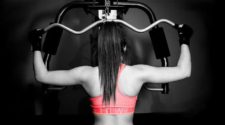A common stereotype of male prisoners is that they’re big, burly men with huge muscles and incredible strength, seemingly ready for any event that requires peak fitness.
However, if you take any time to actually think about this phenomenon, then you’ll realise it’s highly impractical. After all, prisoners spend most of their time in their cells, not in the gym. There may be weights in the yard, but no high-tech pieces of equipment or even a plethora of weights to allow them to follow a bodybuilding routine.
Nonetheless, most prisoners manage to stay in fairly good shape, occasionally gaining a heap of muscle (or at least not losing any size) whilst behind bars.
Now, we’ve already partly touched on one way that prisoners manage to build or maintain their muscles: weightlifting. Prisons may not have the best equipment, but the prisoners are allowed access to enough that they can create a stimulus for muscle growth. The reason this is allowed is because prisoners must be able to defend themselves against dangerous situations due to the hostile nature of some prisons.
As well as this, it’s a good way to pass the time, reduce the need for hospital visits due to ill health, as well as relieve stress. The weights aren’t there to help the prisoners look good, and it’s almost certain that’s not the motivation behind the prisoner’s training because good has no benefit when you’re locked up. They’re there for health and mental reasons predominantly; the aesthetic benefits are just a happy side effect.
Most prisons have a yard that features some sort of bar. You may not realise it, but a bar is an extremely versatile piece of equipment. You can complete pull ups, chin ups, in all their varieties, leg raises, knee raises, hanging ab crunches, dead hangs, dips, and many other exercises which help to build both strength and size.
There’s also room for push-ups, planks, squats, jumps, handstands, and many other bodyweight exercises. All these can be made even harder by the addition of another prisoner leaning or resting on their back or shoulders. Some prisoners also get inventive with their training by filling pillowcases with sand to use as dumbbells, trash bags or buckets with water, and laundry bags with magazines or books.
None of these may sound like they provide a lot of stimulus though it does provide some sort of stimulus, and that’s enough. According to a previous prison inmate, when he asked the most muscular member of the prison he could find exactly how he managed to stay so buff, the reply was that he used a high amount of reps in a short range of motion. This allows you to overload each area of the muscle completely. “You got to pump those muscles up like a balloon until they feel like they’re going to explode,” he explained.
What makes muscles grow?
In order to fully understand how prisoners build their body and manage to stay in such great shape, we must first discuss the main driver behind strength and size. The key to muscle growth is progressive overload. Progressive overload simply means being able to handle more intensity than what you could before. This can mean more weight, more reps, more sets, more time under tension, or less rest. Here are some examples of progressive overload:
- Being able to bench press 70kg for 5 reps one week and then 72.5kg for 5 reps the week after.
- Being able to squat 100kg for 5 reps one week and then 6 reps the week after.
- Being able to do 3 sets of 8 reps of chin ups one week and then 4 sets of 8 reps the week after.
- Being able to hold a plank for 30 seconds one week and then 45 seconds the week after.
- Being able to deadlift 120kg for 3 sets of 6 reps with 3 minutes of rest one week and then for 3 sets of 6 reps with 2 minutes of rest the week after.
All of these show some form of adaptation.
Diet
When discussing body composition, we must include diet. A prisoner’s food intake is regulated and fairly standardized. One missing component of a prisoner’s diet that is common place outside of the guarded walls is alcohol. Alcohol contains a high amount of calories whilst affecting your body’s ability to rest, repair, and function properly. For this reason, booze could impair muscle growth. One pint of beer commonly contains between 160-200 calories and we all know that nobody drinks just one. Wine is not much better at around 100-150 calories per glass and 550-560 calories per bottle.
Time
It’s important to understand that prisoners have a lot more time to put towards exercise than most common people. They also don’t have any hobbies or varieties of ways to pass the time. This means that they have a lot of time to dedicate towards exercise as well as to think of different, new ways to train their body. Prisoners spend their time exercising in the yard for an hour or two followed by the rest of their time eating and resting. Many of us underestimate the sheer power of rest.
Our body does not build muscle and grow in the gym, it grows outside, mainly when we’re sleeping. Sleeping is the time our body dedicates to repairing damage to the body and adapting to the day we’ve had. As prisoners have such a long time to eat and rest, they have a lot of time to grow. It’s really a perfect combination for strength and size.
Motivation
Another contributing factor is motivation. Prisoners need strength and size to earn respect and not get messed with by other inmates. Most of us have other priorities in life other than how we look or our performance in the gym. Unless you’re an athlete, your family, friends, relationships, and work life will most likely take precedence over the gym and your fitness level.
What can we learn from prisoners?
You might have noticed that there are some tips and tricks you can learn from prisoners that you can implement into your own life without having to commit a crime.
1. Focus on Progressive Overload
Progressive overload in any form is the main driver behind muscle growth and strength gains. If you’re short on time, then the best form of progressive overload for you will be to reduce your rest time. If you don’t have access to a lot of equipment, then you’ll want to try and complete more reps. Those who can be slightly more lenient with their time and are fortunate enough to have access to a substantial amount of equipment should overload by trying to add weight on the bar. No matter what your lifestyle is or where you train, there’s a way to adapt your training to create change.
2. Sustain the Right Diet
Diet is the most influential factor behind any body composition change. Are you training your butt off to build muscle but not eating enough calories? You’re not going to grow. Spending hours in the gym but eating too many calories? You’re not going to lose weight. It’s really that simple.
No matter what your goal, it helps to limit your alcohol intake. This doesn’t mean eliminating alcohol completely as this can be understandably impractical. However, excessive drinking or frequent drinking can hinder recovery capabilities as well as provide useless calories. The odd tipple is perfectly fine, but frequently getting drunk can be a real issue if you’re looking to gain muscle or lose fat.
3. Maintain a Clear Goal
Without a clear goal your training can become bland and lost. We can far too easily lose motivation which results in missed gym sessions and food binges. After a while, we become fed up with the way we look in the mirror and how similar we look to when we started. This just creates frustration and anger.
By frequently reminding ourselves of our goal, we can keep our levels of motivation elevated and get more from our training. A motivated training sessions is far more effective than one where you’re tired or can’t be bothered. You can remind yourself of your goal by keeping pictures around the house or talking about your goal with your friends and family.
4. Make No Excuses
Prisoners have very little control over what they can do each and every day. Yet, they still manage to build incredible strength and sculpt physiques to be proud of. You’re in the fortunate position where you do have control over your life and therefore, have even less need to make excuses.
One of the most common excuses people make is that they can’t afford to access a gym. Prisoners only have limited access to weights and even then, other prisoners will be using them, limiting their time even further. Instead, they use their ingenuity to craft weights and create a workout routine that stimulates their bodies to grow. If you can’t afford a gym membership, then think about purchasing versatile equipment such as a pull-up bar or a kettlebell. If you still can’t stretch that far, then why not use a tree branch and objects around the house to use as weights.
Not to mention you already own the most effective piece of equipment known to man: the human body. With this one machine, you can complete push-ups, dips, crunches, squats, lunges, handstands, and a variety of other movements which are all extremely useful for training the body. As well as this, none of them require an absurd amount of space to complete. This makes them highly practical for those who live in smaller homes or buildings.
It’s also a myth that you need a lot of time to maintain your fitness level. Workouts can be done in 30, 20, and sometimes even 10 minutes. Utilising a methodology called HIIT (High Intensity Interval Training), you can stay fit in a very small time frame. All it takes is some passion and dedication.
Couple all of this information with a suitable diet based upon natural ingredients and you can very easily build the body of an athletic prisoner.
Conclusion
As we’ve talked about, gaining muscle can be achieved in a number of various ways. Though it would be helpful, prisoners don’t have access to a range of equipment to get them ripped and swole. Yet, they manage to get by just fine without it. That’s one excuse you can eradicate from your mind.
Prisoners also don’t have access to a dietitian or personal trainer to help them with their diet. They simply eat what they’re given and stop when they’re full. When it comes to eating, a lot can be said for listening to what your mind is telling you.
Many of us have ignored our thoughts for so long, choosing to stay up later than we should or eating more than our stomach wants. By becoming more in tune with our brain, we can establish a real connection with our body that can help us in many different ways, not just in terms of body composition.
There’s nothing magic or out of reach about the way prisoners live, exercise, or eat that makes their physiques, strength, or size unattainable for a general member of the public. All you need to do is to maintain both dedication and patience to your goal and you’ll achieve it.










Leave a Reply